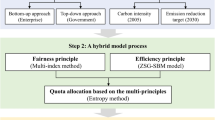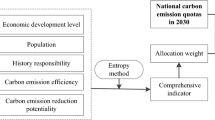Abstract
With the official national unified carbon market launch on July 16, 2021, the allocation and trading of initial carbon quotas between regions will become the focus of research in the future. Based on a reasonable regional initial carbon quota allocation, introducing the concept of carbon ecological compensation and formulating differentiated emission reduction strategies according to the characteristics of different provinces can better guarantee the realization of China’s carbon emission reduction goals. Based on this, this paper first analyzes the distribution effects under different distribution principles from the perspective of fairness and efficiency. Secondly, the Pareto optimal multi-objective particle swarm optimization (Pareto-MOPSO) algorithm is used to build the initial carbon quota allocation optimization configuration model to optimize the allocation results. The optimal initial carbon quota allocation scheme is determined through the comparative analysis of the allocation results. Finally, we explore the combination of carbon quota allocation and the concept of carbon ecological compensation and formulate the corresponding carbon compensation scheme. This study not only reduces the relative sense of exploitation of carbon quota allocation in different provinces but also contributes to the realization of a carbon peak in 2030 and carbon neutrality in 2060 (the “30.60” double carbon target).












Similar content being viewed by others
Data availability
The data used to support the findings of this study are available from the corresponding author upon request.
References
Adam R, Brandt S (1993) The efficiency and equity of marketable permits for CO2 emissions. Resour Energy Econ 15(1):117–146
Böhringer C, Hoffmann T, Manrique-de-Lara-Peñate C (2005) The efficiency costs of separating carbon markets under the EU emissions trading scheme: a quantitative assessment for Germany. Energy Econ 28(1):44–61
Cai W, Ye P (2019) A more scientific allocation scheme of carbon dioxide emissions allowances: the case from China. J Clean Prod 215:903–912
Cui X, Zhao T, Wang J (2021) Allocation of carbon emission quotas in China’s provincial power sector based on entropy method and ZSG-DEA. J Clean Prod 284(7):124683
Dong J, Wu D, Song J, Lu J (2022) Gauging the environmental efficiency with ecological compensation in presence of missing data using data envelopment analysis. Environ Dev Sustain 24(4):5472
Fang G, Liu M, Tian L et al (2018) Optimization analysis of carbon emission rights allocation based on energy justice—The case of China. J Clean Prod 202:748–758
Fang K, Zhang Q, Long Y et al (2019) How can China achieve its intended nationally determined contributions by 2030? A multi-criteria allocation of China’s carbon emission allowance. Appl Energy 241(8):380–389
Gan Z, Zong J (2021) Can ecological compensation improve urban air quality. China Popul Resour Environ 31(10):118–129
Gleick PH, Adams RM, Amasino RM et al (2010) Climate change and the integrity of science. Science 328(5979):689–690
Han R, Tang B, Fan J et al (2016) Integrated weighting approach to carbon emission quotas: an application case of Beijing-Tianjin-Hebei region. J Clean Prod 131:448–459
Hepburn C, Stern N (2008) A new global deal on climate change. Oxf Rev Econ Policy 24(2):259–279
He W, Zhang B, Li Y et al (2021) A performance analysis framework for carbon emission quota allocation schemes in China: perspectives from economics and energy conservation. J Environ Manage 296:113165
Huang W, Shahbaz M, Li H (2022) Decomposition and decoupling of regional carbon emissions: a case of the Yangtze River Delta in China. J Glob Inf Manag 30(6):1–19
Janet, Peace, Timothy et al (2017) The coming carbon market and its impact on the American economy. Policy Society 27(4):305–316
Kong Y, Zhao T, Yuan R, Chen C (2019) Allocation of carbon emission quotas in Chinese provinces based on equality and efficiency principles. J Clean Prod 211:222–232
Li F, Wu F, Chen L (2020) Harmonious allocation of carbon emission permits based on dynamic multi-attribute decision-making method. J Clean Prod 248:119184
Li L, Ye F, Li Y et al (2018) A bi-objective programming model for carbon emission quota allocation: evidence from the Pearl River Delta region. J Clean Prod 205:163–178
Li R, Tang BJ (2016) Initial carbon quota allocation methods of power sectors: a China case study. Nat Hazards 84:1075–1089
Liu X, Cui L, Li B, Du X (2021a) Research on the high-quality development path of China’s energy industry under the target of carbon neutralization. J Beijing Inst Technol (Social Sciences Edition) 23(03):1–8
Liu Z-H, Xu J, Zhang C (2021b) The evolutionary game analysis of inter-provincial horizontal carbon ecological compensation. Soft Science 35(11):115–122
Lv Y, Liu J, Cheng J, Andreoni V (2021) The persistent and transient total factor carbon emission performance and its economic determinants: evidence from China’s province-level panel data. J Clean Prod 316:128198
Ma C, Ren Y, Zhang Y et al (2018) The allocation of carbon emission quotas to five major power generation corporations in China. J Clean Prod 189:1–12
Mu H, Li L, Li N et al (2016) Allocation of carbon emission permits among industrial sectors in Liaoning Province. Energy Procedia 104:449–455
Niklas H, Kornelis B (2005) Calculating historical contributions to climate change-discussing the ‘Brazilian proposal.’ Clim Change 71(1–2):141–173
Pan J-H (2016) Construction, challenges and market expansion of emissions trading system. China Popul Resour Environ 26(08):1–5
Ren J, Bian Y, Xu X et al (2015) Allocation of product-related carbon emission abatement target in a make-to-order supply chain. Comput Ind Eng 80:181–194
Rose A, Zhang Z (2004) Interregional burden-sharing of greenhouse gas mitigation in the United States. Mitig Adapt Strat Glob Change 9(4):477–500
Schmidt RC, Heitzig J (2014) Carbon leakage: grandfathering as an incentive device to avert firm relocation. J Environ Econ Manag 67(2):209–223
Shi B, Li N, Gao Q et al (2022) Market incentives, carbon quota allocation and carbon emission reduction: evidence from China’s carbon trading pilot policy. J Environ Manage 319:115650
Song L (2021) Game research of port and ship emission reduction under carbon quota. Front Sustain Dev 1(5):0003
Tan X-C, Cheng Y-L, Gu B-H (2022) New progress in controlling the total volume of carbon emissions in China: a review on the allocation of provincial carbon emission allowances. Clim Change Res 11(26):1–13
Wan L, Zheng Q, Wu J, Wei Z, Wang S (2022) How does the ecological compensation mechanism adjust the industrial structure? Evidence from China. J Environ Manage 301:113839
Wang Y, Zhao H, Duan F et al (2018) Initial provincial allocation and equity evaluation of China’s carbon emission rights—based on the improved TOPSIS method. Sustainability 10(982):10040982
Winkler H, Fecher RS, Tyani L (2011) Comparing developing countries under potential carbon allocation schemes. Climate Policy 2(4):303–318
Wu L, Li W-X (2019) Research on regional carbon ecological compensation in China from the perspective of equity. China Soft Science 04:184–192
Wu L, Tian Q (2022) Study on regional carbon ecological security and ecological compensation in China under carbon neutralization target. Geogr Res 41(01):149–166
Xu X, Gong Z, Guo W et al (2021) Optimization consensus modeling of a closed-loop carbon quota trading mechanism regarding revenue and fairness. Comput Ind Eng 161:107611
Yang B, Li X, Su Y et al (2020) Carbon quota allocation at the provincial level in China under principles of equity and efficiency. Carbon Management 11(1):11–23
Yan Q, Wang Y, Li Z et al (2019) Coordinated development of thermal power generation in Beijing-Tianjin-Hebei region: evidence from decomposition and scenario analysis for carbon dioxide emission. J Clean Prod 232(C)
Yi W, Zou L, Guo J et al (2011) How can China reach its CO2 intensity reduction targets by 2020? A regional allocation based on equity and development. Energy Policy 39(5):2407–2415
Yu S, Wei Y, Wang K (2014) Provincial allocation of carbon emission reduction targets in China: an approach based on improved fuzzy cluster and Shapley value decomposition. Energy Policy 66:630–644
Yuan K, Zhang M, Gan C et al (2019) Resources and environment in the Yangtze Basin 28(01):21-29
Yuan X-L et al (2020) Study on carbon emission peak forecast and emission reduction potential of China’s industrial sector. J Stat Inf 35(09):72–82
Yu Z, Yu W (2022) Shafting misalignment malfunction quantitative diagnosis based on speed signal SVD-HT and CSF-PPSO-ESN method. Comput Intell Neurosci 2022:7016597
Zhang X, Zhuang G (2015) China provincial carbon emissions differences research progress and prospect. China Popul Resour Environ 25(02):135–143
Zhang Y, Yu Z, Zhang J (2021) Analysis of carbon emission performance and regional differences in China’s eight economic regions: based on the super-efficiency SBM model and the Theil index. PloS One 16(5):0250994
Zhao R, Min N, Geng Y et al (2017) Allocation of carbon emissions among industries/sectors: an emissions intensity reduction constrained approach. J Clean Prod 142(3):3083–3094
Zhou P, Wang M (2016) Carbon dioxide emissions allocation: a review. Ecol Econ 125:47–59
Zhou P, Zhang L, Zhou D et al (2013) Modeling economic performance of interprovincial CO2 emission reduction quota trading in China. Appl Energy 112:1518–1528
Zhou X, Guan X, Zhang M et al (2017) Allocation and simulation study of carbon emission quotas among China’s provinces in 2020. Environ Sci Pollut Res Int 24(8):7088–7113
Zhu B, Jiang M, He K et al (2018) Allocating CO2 allowances to emitters in China: a multi-objective decision approach. Energy Policy 121:441–451
Author information
Authors and Affiliations
Contributions
Conceptualization: Yuan Zhang, Zhen Yu. Data curation: Zhen Yu. Formal analysis: Yuan Zhang. Methodology: Yuan Zhang, Zhen Yu. Writing—original draft: Yuan Zhang. Writing—review and editing: Yuan Zhang, Zhen Yu, Juan Zhang, Wenjie Zhang.
Corresponding author
Ethics declarations
Ethics approval and consent to participate
Not applicable.
Consent for publication
Not applicable.
Competing interests
The authors declare no competing interests.
Additional information
Responsible Editor: V.V.S.S. Sarma
Publisher's note
Springer Nature remains neutral with regard to jurisdictional claims in published maps and institutional affiliations.
Rights and permissions
Springer Nature or its licensor (e.g. a society or other partner) holds exclusive rights to this article under a publishing agreement with the author(s) or other rightsholder(s); author self-archiving of the accepted manuscript version of this article is solely governed by the terms of such publishing agreement and applicable law.
About this article
Cite this article
Zhang, Y., Yu, Z., Zhang, J. et al. Study on the initial carbon quota allocation and spatial balance compensation strategy at the provincial level in China. Environ Sci Pollut Res 30, 67150–67173 (2023). https://doi.org/10.1007/s11356-023-26950-1
Received:
Accepted:
Published:
Issue Date:
DOI: https://doi.org/10.1007/s11356-023-26950-1




